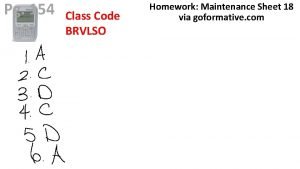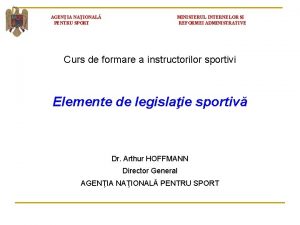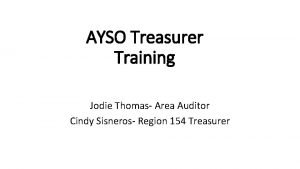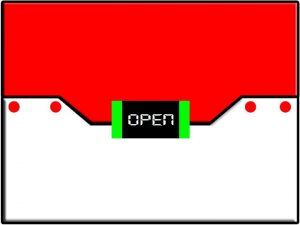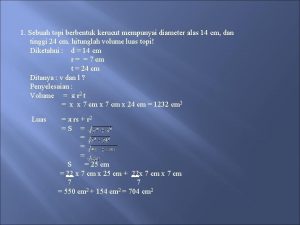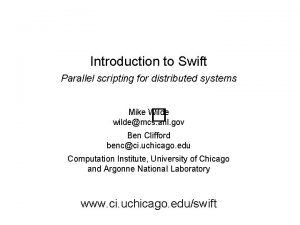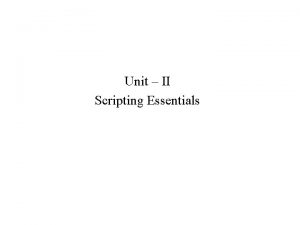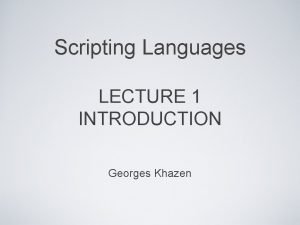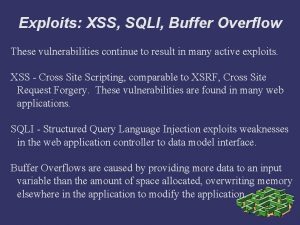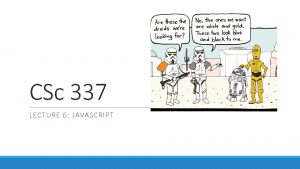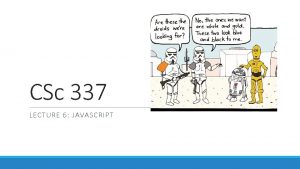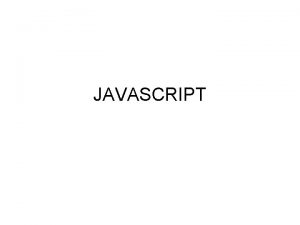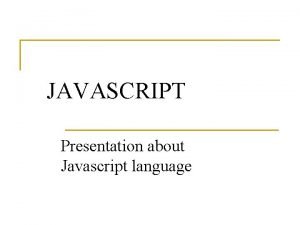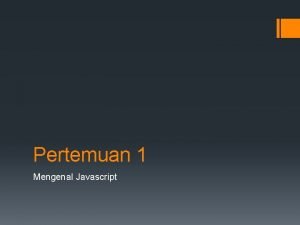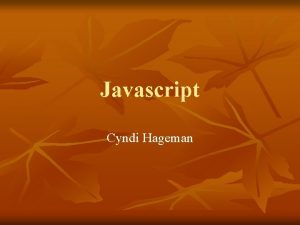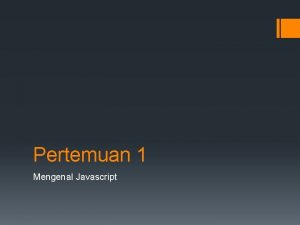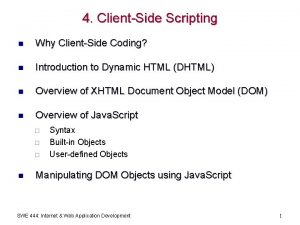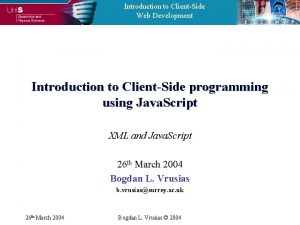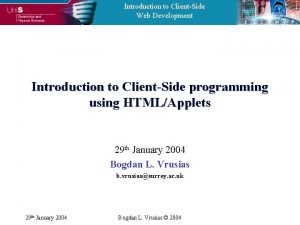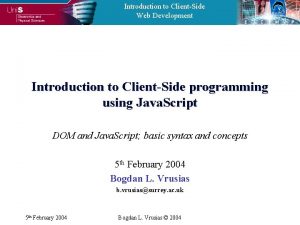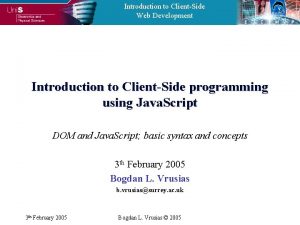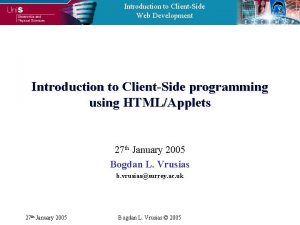CSE 154 LECTURE 6 JAVASCRIPT Clientside scripting clientside


















![Arrays var name = []; // empty array var name = [value, . . Arrays var name = []; // empty array var name = [value, . .](https://slidetodoc.com/presentation_image_h2/b05d9d2d317746d40bea5b1380423c93/image-19.jpg)
![Array methods var a = ["Stef", "Jason"]; a. push("Brian"); a. unshift("Kelly"); a. pop(); a. Array methods var a = ["Stef", "Jason"]; a. push("Brian"); a. unshift("Kelly"); a. pop(); a.](https://slidetodoc.com/presentation_image_h2/b05d9d2d317746d40bea5b1380423c93/image-20.jpg)









- Slides: 29

CSE 154 LECTURE 6: JAVASCRIPT

Client-side scripting • client-side script: code runs in browser after page is sent back from server often this code manipulates the page or responds to user actions

What is Java. Script? • a lightweight programming language ("scripting language") • used to make web pages interactive § insert dynamic text into HTML (ex: user name) § react to events (ex: page load user click) § get information about a user's computer (ex: browser type) § perform calculations on user's computer (ex: form validation) • a web standard (but not supported identically by all browsers) • NOT related to Java other than by name and some syntactic similarities

Java. Script vs. Java • interpreted, not compiled • more relaxed syntax and rules § fewer and "looser" data types § variables don't need to be declared § errors often silent (few exceptions) + = Java. Script • key construct is the function rather than the class § "first-class" functions are used in many situations • contained within a web page and integrates with its HTML/CSS content

Linking to a Java. Script file: script <script src="filename" type="text/javascript"></script> HTML <script src="example. js" type="text/javascript"></script> HTML • script tag should be placed in HTML page's head • script code is stored in a separate. js file • JS code can be placed directly in the HTML file's body or head (like CSS) • but this is bad style (should separate content, presentation, and behavior)

A Java. Script statement: alert("message"); alert("IE 6 detected. JS Suck-mode enabled. "); JS output • a JS command that pops up a dialog box with a message

Variables and types var name = expression; var age = 32; var weight = 127. 4; var client. Name = "Connie Client"; JS JS • variables are declared with the var keyword (case sensitive) • types are not specified, but JS does have types ("loosely typed") • Number, Boolean, String, Array, Object, Function, Null, Undefined • can find out a variable's type by calling typeof

Number type var enrollment = 99; var median. Grade = 2. 8; var credits = 5 + 4 + (2 * 3); • integers and real numbers are the same type (no int vs. double) • same operators: + - * / % ++ -- = += -= *= /= %= • similar precedence to Java • many operators auto-convert types: "2" * 3 is 6 JS

String type var var s = "Connie Client"; f. Name = s. substring(0, s. index. Of(" ")); len = s. length; s 2 = 'Melvin Merchant'; // "Connie" // 13 // can use "" or ' ' • methods: char. At, char. Code. At, from. Char. Code, index. Of, last. Index. Of, replace, split, substring, to. Lower. Case, to. Upper. Case • char. At returns a one-letter String (there is no char type) • length property (not a method as in Java) • concatenation with + : 1 + 1 is 2, but "1" + 1 is "11"

More about String • escape sequences behave as in Java: ' " & n t \ • to convert between numbers and Strings: var var var count = 10; s 1 = "" + count; s 2 = count + " bananas, ah ah!"; n 1 = parse. Int("42 is the answer"); n 2 = parse. Float("booyah"); // // "10" "10 bananas, ah ah!" 42 Na. N • to access characters of a String, use [index] or char. At: var first. Letter = s[0]; var first. Letter = s. char. At(0); var last. Letter = s. char. At(s. length - 1);

Comments (same as Java ) // single-line comment /* multi-line comment */ • identical to Java's comment syntax • recall: 3 comment syntaxes • HTML: <!-- comment --> • CSS/JS: /* comment */ • Java/JS: // comment JS

for loop (same as Java) for (initialization; condition; update) { statements; } var sum = 0; for (var i = 0; i < 100; i++) { sum = sum + i; } var s 1 = "hello"; var s 2 = ""; for (var i = 0; i < s. length; i++) { s 2 += s 1[i] + s 1[i]; } // s 2 stores "hheelllloo“ JS JS JS

Math object var rand 1 to 10 = Math. floor(Math. random() * 10 + 1); var three = Math. floor(Math. PI); JS • methods: abs, ceil, cos, floor, log, max, min, pow, random, round, sin, sqrt, tan • properties: E, PI

Logical operators • Relational: > < >= <= • Logical: && || ! • Equality: == != === !== • most logical operators automatically convert types. These are all true: • 5 < "7" • 42 == 42. 0 • "5. 0" == 5 • The === and !== are strict equality tests; checks both type and value: • "5. 0" === 5 is false

Boolean type var i. Like. JS = true; var ie. Is. Good = "IE 6" > 0; if ("web dev is great") { if (0) { /* false */ } // false /* true */ } • any value can be used as a Boolean • "falsey" values: 0, 0. 0, Na. N, "", null, and undefined • "truthy" values: anything else • converting a value into a Boolean explicitly: • var bool. Value = Boolean(other. Value); • var bool. Value = !!(other. Value); JS

Special values: null and undefined var ned = null; var benson = 9; var caroline; // at this point in the code, // ned is null // benson's 9 // caroline is undefined • undefined : has not been declared, does not exist • null : exists, but was specifically assigned an empty or null value • Why does Java. Script have both of these? JS

if/else statement (same as Java) if (condition) { statements; } else { statements; } • identical structure to Java's if/else statement • Java. Script allows almost anything as a condition JS

while loops (same as Java) while (condition) { statements; } do { statements; } while (condition); JS JS • break and continue keywords also behave as in Java but do not use them in this class!
![Arrays var name empty array var name value Arrays var name = []; // empty array var name = [value, . .](https://slidetodoc.com/presentation_image_h2/b05d9d2d317746d40bea5b1380423c93/image-19.jpg)
Arrays var name = []; // empty array var name = [value, . . . , value]; // pre-filled name[index] = value; // store element PHP var ducks = ["Huey", "Dewey", "Louie"]; var stooges = []; stooges[0] = "Larry"; stooges[1] = "Moe"; stooges[4] = "Curly"; stooges[4] = "Shemp"; // // // stooges. length is is is 0 1 2 5 5 • two ways to initialize an array • length property (grows as needed when elements are added) PHP
![Array methods var a Stef Jason a pushBrian a unshiftKelly a pop a Array methods var a = ["Stef", "Jason"]; a. push("Brian"); a. unshift("Kelly"); a. pop(); a.](https://slidetodoc.com/presentation_image_h2/b05d9d2d317746d40bea5b1380423c93/image-20.jpg)
Array methods var a = ["Stef", "Jason"]; a. push("Brian"); a. unshift("Kelly"); a. pop(); a. shift(); a. sort(); // // // Stef, Jason, Brian Kelly, Stef, Jason, Stef JS • array serves as many data structures: list, queue, stack, . . . • methods: concat, join, pop, push, reverse, shift, slice, sort, splice, to. S tring, unshift • push and pop add / remove from back • unshift and shift add / remove from front • shift and pop return the element that is removed

Splitting strings: split and join var s = "the quick brown fox"; var a = s. split(" "); // ["the", "quick", "brown", "fox"] a. reverse(); // ["fox", "brown", "quick", "the"] s = a. join("!"); // "fox!brown!quick!the“ JS • split breaks apart a string into an array using a delimiter • can also be used with regular expressions surrounded by /: var a = s. split(/[ t]+/); • join merges an array into a single string, placing a delimiter between them

Defining functions function name() { statement ; . . . statement ; } JS function my. Function() { alert("Hello!"); alert("How are you? "); } JS • the above could be the contents of example. js linked to our HTML page • statements placed into functions can be evaluated in response to user events

Event-driven programming • JS programs have no main; they respond to user actions called events • event-driven programming: writing programs driven by user events

Event handlers <element attributes onclick="function(); ">. . . HTML <div onclick="my. Function(); ">Click me!</div> HTML Click me! • Java. Script functions can be set as event handlers • when you interact with the element, the function will execute • onclick is just one of many event HTML attributes we'll use HTML

Buttons: <button> the canonical clickable UI control (inline) <button onclick="my. Function(); ">Click me!</button> HTML output • button's text appears inside tag; can also contain images • To make a responsive button or other UI control: 1. choose the control (e. g. button) and event (e. g. mouse click) of interest 2. write a Java. Script function to run when the event occurs 3. attach the function to the event on the control

Accessing an element: document. get. Element. By. Id var name = document. get. Element. By. Id("id"); JS <img id="icon 01" src="images/octopus. jpg" alt="an animal" /> <button onclick="change. Image(); ">Click me!</button> HTML function change. Image() { var octopus. Image = document. get. Element. By. Id("icon 01"); octopus. Image. src = "images/kitty. gif"; } JS output • document. get. Element. By. Id returns the DOM object for an element with a given id

<input> <!-- 'q' happens to be the name of Google's required parameter --> <input type="text" name="q" value="Colbert Report" /> <input type="submit" value="Booyah!" /> HTML output • input element is used to create many UI controls • an inline element that MUST be self-closed • name attribute specifies name of query parameter to pass to server • type can be button, checkbox, file, hidden, password, radio, reset, submit, text, . . . • value attribute specifies control's initial text

Text fields: <input> <input type="text" size="10" maxlength="8" /> Net. ID <input type="password" size="16" /> Password <input type="submit" value="Log In" /> HTML output • input attributes: disabled, maxlength, readonly, size, value • size attribute controls onscreen width of text field • maxlength limits how many characters user is able to type into field

Text boxes: <textarea> a multi-line text input area (inline) <textarea rows="4" cols="20"> Type your comments here. </textarea> HTML output • initial text is placed inside textarea tag (optional) • required rows and cols attributes specify height/width in characters • optional readonly attribute means text cannot be modified
 Cse 154
Cse 154 Cse 154
Cse 154 01:640:244 lecture notes - lecture 15: plat, idah, farad
01:640:244 lecture notes - lecture 15: plat, idah, farad Equal protection for english language learners
Equal protection for english language learners Data system
Data system Homework 154
Homework 154 Inst154
Inst154 Ordinul 154 din 2004
Ordinul 154 din 2004 Duties of treasurer
Duties of treasurer Uchicago cs 154
Uchicago cs 154 Anastasiya vitko stanford
Anastasiya vitko stanford Diketahui volume suatu balok 154 cm
Diketahui volume suatu balok 154 cm Dimensional analysis steps
Dimensional analysis steps Cs 154 sjsu
Cs 154 sjsu Luas topi berbentuk kerucut
Luas topi berbentuk kerucut Senet154
Senet154 Inst-154
Inst-154 Al baqarah 154-157
Al baqarah 154-157 Sage 100 scripting
Sage 100 scripting Swift scripting language
Swift scripting language Lab 7-8: customize or write simple scripts
Lab 7-8: customize or write simple scripts Tokens marketo
Tokens marketo Characteristics of scripting languages
Characteristics of scripting languages Strongly typed scripting language
Strongly typed scripting language Common cause of buffer overflow cross-site scripting
Common cause of buffer overflow cross-site scripting Tabular editor advanced scripting
Tabular editor advanced scripting Language
Language Birt scripting
Birt scripting Jmp scripting
Jmp scripting Boolean algebra
Boolean algebra





